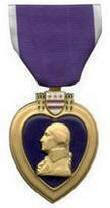Johnny Pollock
Ballplayers Wounded in Combat
| Date and Place of Birth: | April 2, 1913 Scranton, PA |
| Date and Place of Death: | June 25, 2000 Jamestown, NY |
| Baseball Experience: | Minor League |
| Position: | Catcher |
| Rank: | Sergeant |
| Military Unit: | 36th Infantry Division US Army |
| Area Served: | Mediterranean Theater of Operations |
John J. Pollock was born on April 2, 1913, in Scranton, Pennsylvania. A
right-handed hitting catcher, he played baseball at Tech High School,
and played semi-pro ball around Pennsylvania, before signing with the
Jamestown Falcons in 1939 - the innaugural season of the Class D PONY
League. The 26-year-old played just a handful of games before being
released and returned to semi-pro baseball. In 1940, he played briefly
with the London Pirates in the same league and batted .314 in 21 games.
Pollock returned to Jamestown in 1941. He caught 80 games with the
Falcons and batted .273, making the league all-star team. "He's squat on
slightly bowed legs," described a Jamestown sports reporter. "Isn't the
greatest hitter in the world but a dangerous one; not as fast as many on
the lanes, but one of the headiest and scrappiest grabbers that ever
picked up a catcher's pud anywhere."
In 1942, Pollock was invited to spring training at Fort Lauderdale,
Florida, with the Buffalo Bisons of the Class AA International League.
When the team headed north for the regular season, Pollock was on the
squad and caught the season opener against Newark. It was to be the only
game he would play for them that season as military service called.
Pollock served with the 36th Infantry Division and was shipped to North
African in April 1943. When the German forces surrendered in Tunisia,
Pollock remained and found time to play baseball. He caught for the Army
and Navy All-Stars, played 57 games, batted .395, and was picked as the
most valuable player in the North Africa Theater of Operation. "They
just couldn't get me out," he recalled. "I hammered doubles, triples,
homers, beat out bunts, did everything. I can tell you one thing.
African weather is ideal for baseball.
"Baseball was the biggest thing for the servicemen in the war," he said.
"We played to crowds of 20,000 to 30,000 and I saw more kids with
natural talent than I have ever seen while playing pro ball. I believe
more atars will come out of the army than from any other source ever.
The reason? Every kid who showed the least signs of talent was given a
chance to play over there."
Pollock also met Al Schact, the Clown Prince of Baseball, while in
Tunisia. ""We pulled the same routine as we had in Jamestown's Municipal
Stadium in 1941," he said. "When a ball I threw struck Al, hiding behind
a huge glove, squarely in the back. Schacht remembered that incident and
the talk we had was one of my most enjoyable experiences overseas."
Sergeant Pollock's baseball-playng days under the North African sun were
limited, however. The 36th Infantry Division went into action on
September 9, 1943, when it landed by sea at Paestum, Italy, and fought
in the Battle of Salerno against intense German opposition.
Pollock was wounded twice in action in Italy. The first time was at
Altavilla Silentina, in September 1943, when he was hit in the body by
shrapnel. On the second occasion, in Decemebr 1944, at Cassino, shrapnel
ripped ligaments in his left leg.
He spent eight months at the 32nd Station Hospital, near Naples, and was
named athletic director at hospital during that time.
Pollock returned home in 1945, and was looking forward to spring
training with Buffalo. "I'm in a lot better shape than I was when I
entered the army," he told the Jamestown Post-Journal in December. "I'll
guarantee that. I weigh 185 pounds, 25 pounds more than I did when I
played with the Falcons. I'm going to make the Bisons know I'm in camp
next spring, you bet you."
Approaching 33 years of age, he married Gladys Nelson McAvay of
Jamestown, in February 1946, before heading south for spring training
with the Bisons. He didn't make the team but returned to Jamestown to
play with the Falcons, appearing in 81 games and batting a respectable
.289. Pollock was asked if he minded playing Class D ball in Jamestown:
"Why should I mind?," he replied. "This is my home. My family is here.
And it's a good town to play ball in."
Pollock was released by Jamestown in February 1947. He played 12 games
for the Bradford Blue Wings, also a PONY League club, before leavig the
professional game. He continued to play semi-pro ball in Jamestown
through the 1950s.
Johnny Pollock passed away on June 25, 2000. He was 87 years old and is
buried at Holy Cross Cemetery in Jamestown.
Date Added January 2, 2018
Can you add more information to this biography and help make it the best online resource for this player? Contact us by email
Read Baseball's Greatest Sacrifice Through The Years - an online year-by-year account of military related deaths of ballplayers
Baseball's Greatest Sacrifice is associated with Baseball Almanac
Baseball's Greatest Sacrifice is proud to be sponsored by

